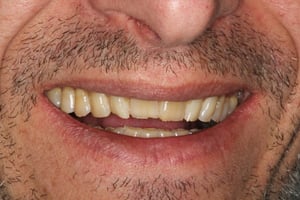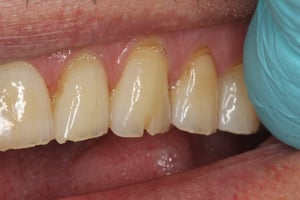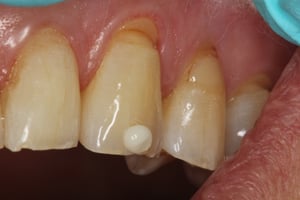Repairing a small chip on the incisal edge can be very difficult to match the color and very difficult to obtain a long lasting permanent result. This is especially true if the patient grinds or clenches their teeth. It can be helpful to inform the patient to be careful of bad habits, such as biting nails, pencils, or pens and biting down on hard foods. A night guard should be advised to protect the teeth from hard occlusal trauma at night. When the composite restoration comes out and the patient didn’t follow the dentist’s advice, they have themselves to blame! Getting the shade correct on an anterior tooth is also very important. This article will show how a new composite material called OMNICHROMA (Tokuyama Dental America) works well to blend into the color of the natural tooth using structural color.
 Figure 1 Figure 1 |
 Figure 2 Figure 2 |
History
The patient is a 40 year-old male who chipped tooth #11. The patient had worn down the incisal edges of his anterior teeth and the enamel worn thin on the facial. The patient was advised that the restoration may not last long and that he may eventually need crowns or veneers. The patient was okay with the fact that the restoration was not going to last long-term.
Treatment
Teeth #6-11 were rough and uneven on the incisal edge. These teeth were smoothed down with a coarse disc (Soflex-XT, 3M, St. Paul, MN) to eliminate all the sharp edges. Since the chipped tooth #11 was all in enamel, no anesthesia was necessary. Tooth #11 was prepared by beveling with a tapered diamond bur the enamel edges. This allows for a stronger enamel bond and a better color blend of the composite to tooth. The tooth was acid etched with 35% Phosphoric Acid (Ultra Etch, Ultradent, South Jordan, UT) and rinsed with water. The bonding agent (Bond Force, Tokuyama Dental America) was then applied to the prepared tooth surface.
 Figure 3 Figure 3 |
 Figure 4 Figure 4 |
The composite chosen to be used was OMNICHROMA (Tokuyama Dental America) due to its handling properties, strength, and ability to blend its color to match the surrounding tooth structure. OMNICHROMA (Tokuyama Dental America) was applied, sculpted, and light cured. A coarse disc (Soflex-XT, 3M, St. Paul, MN) was used to smooth and contour the restoration. The bite was checked to make sure the restoration was out of occlusion. The use of progressively finer discs made possible a restoration with a high polish.
 Figure 5 Figure 5 |
 Figure 6 Figure 6 |
 Figure 7 Figure 7 |
The patient was happy with the result and was advised to be careful and wear a night guard. The use of a single-shade composite, like OMNICHROMA (Tokuyama Dental America), works great on small incisal chips and the color match is spot-on with both dark and light teeth. The shade selection is very easy since the composite material blends into the natural tooth color.
Figures
Figure 1: Smile pre-op view. (2875)
Figure 2: 1:1 pre-op view shows the chipped incisal edge of tooth #11. (2876)
Figure 3: The lingual aspect was covered with OMNICHROMA BLOCKER (Tokuyama Dental America) to prevent shade-matching interference. (2878)
Figure 4: OMNICHROMA (Tokuyama Dental America) was placed over the facial of tooth #11. (2880)
Figure 5: 1:1 post-op view shows an excellent color blending with OMNICHROMA (Tokuyama Dental America). (2882)
Figure 6: The post-op smile view shows that the incisal edges of teeth #6-11 have been smoothed. (2883)
Figure 7: This post-op view shows the Class V restorations completed on teeth #11-13. (3072)
References
- Fahl N. Mastering composite artistry to create anterior masterpieces, part 2. J Cosmetic Dent. 2010; 26(4):42-55.
- Fahl N Jr. Mastering composite artistry to create anterior masterpieces—Part 1. J Cosmetic Dent. 2010;26(3):56-68.
- Hatkar, P. Preserving Natural Tooth Structure with Composite Resin. Journal of Cosmetic Dentistry, Volume 26 Number 3, 2010 .Fall 26-36.
- Fahl Jr, Newton. Achieving Lifelike Anterior Composite Restorations. Journal of Cosmetic Dentistry, Volume 28 Number 4, Winter 2013 :60-72.
- Peyton, James. Finishing and Polishing Techniques: Direct Composite Resin Restorations. Practical Periodontics and Aesthetic Dentistry 2004, May pg.293.

